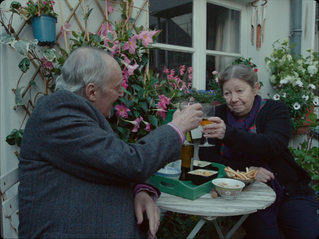Butterfly
- Jessica Moore

- Jan 5, 2022
- 2 min read
Shûji Terayama, 1974

Somewhere amidst Shūji Terayama’s chimeric short, a woman glances at the camera. Eyes emerge from the papery cloth of a projector screen. Silhouettes slip into frame. Much like spectators of an art installation, the silhouettes pore over and react to the image in front of them, obstructing our view. The woman on screen, who appears to look not at them but through them to us, exists unaware of such multiverses of object-subject.
Terayama is no stranger to playing with the meta-textures of his films. Much like The Woman with Two Heads, featured in our On Body and Soul issue, Butterfly revels in the stratospheric potential of cinema. Bodies exist in distinct planes of consciousness, as unknowable figures, superseded by projections. Virtuality, or projected images, take precedence over what is real, amorphous shapes over familiarity.
As if swirling in a petri dish of orange and pink oils, the images in Butterfly stand for a multitude of haptic pleasures―sex, eating, touch. The aftermath of a hedonistic party is an apt location for such modes of behaviour; details of empty bottles and half-eaten cake form an epicurean tapestry. Shrouded in an air of decadence and sensorial gratification, bodies are pulled out of slumber and move with an almost mechanical quality, as if deliberately exaggerating their gestures, and thus acknowledging and manipulating the camera's scrutiny.

Our perception is frequently obstructed by the individuals who stand in front of the screen. Attention diverted, we search through the crowd in the hope of sharing their vision. Refusing us such a straightforward point of entry, Terayama sees the cluster of viewers to bear their own spectacularity. Through their own rhythms of movement, they embody a slippage between object and viewer. This transitional quality is at home in such a visually indulgent film. We are encouraged to embrace the instability of the projector's spectators and accept their anonymity.
Terayama twists any any semblance of internal logic that typically guides an audience’s perception. As if watching two films at once, two worlds colliding on celluloid, we are met with a dialogue of abrupt and intoxicating effigies. Perhaps this is Terayama’s artistic philosophy realised: the possibilities of cinema's permeability. Butterfly obscures the line of separation between objects and their viewers. Never quite aligned with the crowd of spectators, though in them we certainly see something of ourselves, the boundary shifts. We move closer to the projection's luculent veil ― we reach out with arms outstretched.








Comments